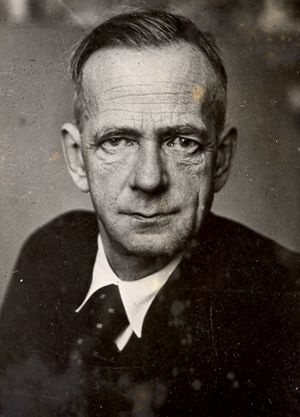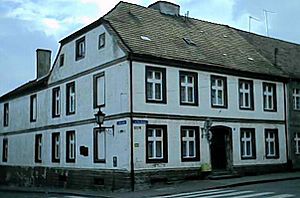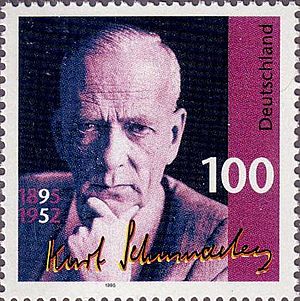Kurt Schumacher facts for kids
Quick facts for kids
Kurt Schumacher
|
|
|---|---|

Schumacher between 1945 and 1948
|
|
| Leader of the Social Democratic Party | |
| In office 10 May 1946 – 20 August 1952 |
|
| Preceded by | Hans Vogel |
| Succeeded by | Erich Ollenhauer |
| Personal details | |
| Born |
Curt Ernst Carl Schumacher
13 October 1895 Kulm, West Prussia, German Empire (now Chełmno, Poland) |
| Died | 20 August 1952 (aged 56) Bonn, West Germany |
| Political party | SPD |
| Alma mater | University of Halle-Wittenberg |
| Occupation | Jurist, politician |
Kurt Schumacher (born Curt Ernst Carl Schumacher; October 13, 1895 – August 20, 1952) was an important German politician. He led the Social Democratic Party of Germany (SPD) starting in 1946. In 1949, he became the first Leader of the Opposition in the new West German parliament, called the Bundestag. He held both these jobs until he passed away.
Schumacher was a key person in building democracy in Germany after World War II. He was against the government led by Konrad Adenauer. But he was even more strongly against the Socialist Unity Party of Germany in East Germany. During the Weimar Republic (the German government before the Nazis), he stood against extreme groups. This included the Nazi Party and the Communist Party of Germany (KPD). He even called the KPD "red-painted Nazis" because he saw them as similar to the Nazis.
Contents
Early Life and Education
Kurt Schumacher was born in a town called Kulm. This town was in West Prussia, which is now part of Poland. His father was a small business owner and a member of a liberal political party.
Kurt was a very smart student. When World War I started in 1914, he stopped his studies right away. He joined the German Army. In December 1914, he was badly hurt in Poland. His right arm had to be removed. After getting sick with dysentery, he left the army. He received a medal called the Iron Cross Second Class for his service.
After the war, Schumacher went back to school. He studied law and politics at universities in Halle, Leipzig, and Berlin. He finished his studies in 1919.
Joining the Social Democratic Party
Inspired by a thinker named Eduard Bernstein, Schumacher became a strong believer in socialism. In 1918, he joined the Social Democratic Party of Germany (SPD). After the German Empire fell, he helped lead groups of former soldiers. These groups formed Workers and Soldiers Councils in Berlin. However, he did not support extreme left-wing groups trying to take power.
In 1920, the SPD sent him to Stuttgart. There, he worked as an editor for the party's newspaper, the Schwäbische Tagwacht.
Political Career Before the Nazis
In 1924, Schumacher was elected to the state parliament in Free People's State of Württemberg. By 1928, he became the leader of the SPD in that state. He helped organize socialist groups to stand against the rising Nazi Party.
In 1930, he was elected to the national parliament, called the Reichstag. In August 1932, he joined the SPD's main leadership group. At 38 years old, he was the youngest SPD member in the Reichstag.
Standing Up to the Nazis
Schumacher was very much against the Nazis. In a speech in the Reichstag on February 23, 1932, he strongly criticized Nazism. He said it was "a continuous appeal to the inner swine in human beings." He also stated that the Nazi movement was good at "ceaselessly mobilizing human stupidity."
In July 1933, Schumacher was arrested. This was two weeks before the SPD was banned by the Nazis. He was badly beaten in prison. Schumacher was offered a chance to be released if he promised to stop all political activities. But he refused to sign this promise, unlike some other political prisoners.
He spent the next ten years in terrible Nazi concentration camps. These included Heuberg, Kuhberg, Flossenbürg, and Dachau. These camps were first used to imprison people the Nazis disliked. This included Jews, socialists, communists, and criminals.
After 1940, the camps became very crowded. Many prisoners were brought from the eastern war front. This led to diseases and starvation. In 1941, the Nazis started a program to kill prisoners who were too sick to work. Schumacher and some other disabled war veterans were spared. They showed their war medals, proving they were injured fighting for Germany in World War I. Still, conditions in the camps got worse. By 1943, almost half of the prisoners died.
In 1943, Schumacher was very ill and close to death. His brother-in-law managed to convince a Nazi official to release him. Schumacher was arrested again in late 1944. He was in the Neuengamme camp when British forces arrived in April 1945 and freed the prisoners.
After World War II
After the war, Schumacher wanted to lead the SPD and bring socialism to Germany. By May 1945, he was already working to restart the SPD in Hanover. He did this even without permission from the countries occupying Germany.
He soon had a disagreement with Otto Grotewohl. Grotewohl was the SPD leader in the part of Germany controlled by the Soviet Union. Grotewohl thought the SPD should join with the Communist Party (KPD). This would create one united socialist party. Schumacher disagreed with this idea. In August, he called an SPD meeting in Hanover. There, he was chosen as the leader of the party in Western Germany.
In January 1946, the British and Americans allowed the SPD to become a national party again. Schumacher was chosen as its leader. He had a lot of respect because he was the only SPD leader who had stayed in Germany during the Nazi period without working with them. He believed he had the right to lead Germany.
However, Schumacher faced a challenge from Konrad Adenauer. Adenauer was the former mayor of Cologne. The Americans, who did not want any kind of socialism in Germany, supported Adenauer for leadership. Adenauer brought together many conservative groups into a new party, the Christian Democratic Union of Germany (CDU).
Schumacher campaigned from 1948 to 1949 for a united socialist Germany. He especially wanted to make large industries owned by the government. He blamed the owners of these industries for helping the Nazis rise to power. When the occupying powers disagreed with his ideas, he criticized them. Adenauer, on the other hand, was against socialism. He believed that cooperating with the Allies was the fastest way for Germany to regain its own government.
Schumacher wanted a new constitution for Germany. He wanted a strong national president, believing he would get that job. The first plan for the 1949 Grundgesetz (Germany's constitution) suggested a weak national government. This was favored by both the Allies and the CDU. Schumacher refused to give in. Eventually, the Allies agreed to some of Schumacher's demands. They wanted the new German state to start working quickly because of the challenge from the Soviet Union. The new federal government would be stronger than the individual states, but the president would have limited powers.
The 1949 Election
Germany's first national elections were held in August 1949. Schumacher was sure he would win, and many people agreed. But Adenauer's new CDU party had some advantages over the SPD. Much of the SPD's traditional support base was now in the Soviet-controlled East Germany. Also, the more conservative parts of Germany were in the new West Germany. The American and French occupying powers also favored Adenauer and helped his campaign. The British remained neutral.
The start of the Cold War also played a role. The actions of the Soviets and German communists in East Germany made many people in Germany, and elsewhere, turn against socialism. The SPD might have won an election in 1945, but by 1949, things had changed. Even though the SPD became very critical of the new East German government, the party was still partly hurt by being linked to socialism. Schumacher tried hard to show the difference between his "democratic socialism" and what was happening in East Germany. He even called the communists "red-painted fascists."
Another factor was the recovery of the German economy. This was mainly due to economic changes made by the CDU's Ludwig Erhard. Schumacher's health was also getting worse. In September 1948, he had one of his legs amputated. Germans admired his courage, but they wondered if he could handle the duties of chancellor.
In the election, Schumacher's SPD won the most seats of any single party. However, the CDU and its sister party (CSU) together won more seats. The CDU was able to form a government with other parties. Adenauer was elected chancellor, which was a big surprise for Schumacher. He refused to cooperate in parliament and criticized the CDU. He called them agents of rich business owners and foreign powers.
Schumacher was also against new European groups forming, like the Council of Europe and the European Coal and Steel Community. He saw them as ways to make capitalism stronger and keep Allied control over Germany. Other socialist parties in Western Europe disagreed with him. Eventually, the SPD party overruled him and sent representatives to the Council of Europe.
Later Life and Legacy
During Adenauer's first time as chancellor, Schumacher continued to oppose his government. But Germany's economy grew quickly, the Cold War became more intense, and Adenauer successfully helped Germany rejoin the international community. These things weakened Schumacher's position. The SPD began to have serious doubts about going into another election with Schumacher as their leader. This was especially true after he had a stroke in December 1951.
The party did not have to make a difficult decision because Schumacher died suddenly in August 1952.
See also
 In Spanish: Kurt Schumacher para niños
In Spanish: Kurt Schumacher para niños



